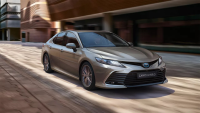Japanese reliability or German attention to detail, Toyota Camry or Volkswagen Passat? Let's make a comparison and find out which is better.
It's hard to imagine more in-demand business sedans on the market than these two cars. Each of them is loved by drivers, and it seems that no matter what manufacturers put on their cars, no matter how they modernize them, they will still be bought.
In 2015, companies released new versions of the legends: the VW Passat B8 and the Toyota Camry V50 restyled. What has changed? Which car is better? And the main question: are they worth their money? Let's take a closer look at the models and, as usual, let's start with the exterior.
Exterior
The new Passat remained recognizable, although the manufacturers have introduced new outlines into the design. It was assembled on the same platform as the Passat B7. The significant difference is in the height - the roof of the new sedan generation is lower.
When designing the body, engineers wanted to create a sportier style. The lines are sharper and the "face" is more aggressive. At the front, a horizontal chrome plaque shines, which runs along the false grille and is continued in the headlights.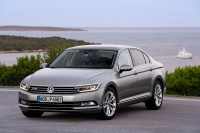 By the way, the headlights of the new VW are LED. For an additional fee you can get fully LED optics, including the turn signals.
By the way, the headlights of the new VW are LED. For an additional fee you can get fully LED optics, including the turn signals.
In general, the car looks more modern, but German conservatism inevitably catches the eye. Volkswagen is extremely reluctant to make changes to its models, so we should not wait for cardinal innovations.
The new model is very similar to the Volkswagen Passat B7. Despite this, the car looks simple, tasteful and with a note of sporty zeal.
Separately we want to mention the Volkswagen Passat SS, which was created specifically for the North American market. It was developed on the basis of a standard Passat, but became lower, wider and longer brother.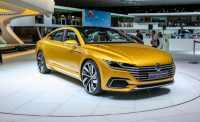 This appearance made the car more aggressive, but it had a negative impact on the practicality of the model. However, it is worth mentioning that the car reached its goal - the Passat began to sell successfully in America.
This appearance made the car more aggressive, but it had a negative impact on the practicality of the model. However, it is worth mentioning that the car reached its goal - the Passat began to sell successfully in America.
The restyling of the Toyota Camry was also received positively. Compared to the Camry V40, the new model has become sharper and more defiant. Although this is not said at all about the handling.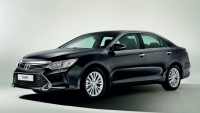 On the front bumper is a huge air intake, inspiring fear in drivers who barely noticed the car in the rearview mirror.
On the front bumper is a huge air intake, inspiring fear in drivers who barely noticed the car in the rearview mirror.
But unlike the Passat, the new Camry looks simpler. Although the German is conservative, even it could not surpass Toyota in terms of restrained design. The minimum of lines and stamps on body elements. All charisma is concentrated only in the forward part. The other sides of Toyota's body are very simple and minimalistic. However, this does not prevent the updated sedan from looking more attractive.
Although both cars are no longer young - the models were released in 2015. - Their looks can and do compete with the already new sedans of their class. This is evidenced by the number of sales.
Interior
Toyota Camry and Volkswagen Passat are very similar in purpose, but different in its implementation. Both cars sought to create a comfortable, presentable, but not pretentious interior of the premium class.
Getting into the new Passat B8, you realize two important things at once. Firstly: VAG's conservatism can be traced even inside. The manufacturer changed almost nothing and used the proven layout of the controls, slightly improving them. And secondly: Volkswagen Passat B8 is not Skoda, but also not Audi! And this thought will help you to answer the question, whether it is necessary to buy this model.
The manufacturer changed almost nothing and used the proven layout of the controls, slightly improving them. And secondly: Volkswagen Passat B8 is not Skoda, but also not Audi! And this thought will help you to answer the question, whether it is necessary to buy this model.
The boast of the new Volkswagen Passat is a huge 12-inch display in place of the on-board computer. All data on speed, engine speed, temperature, fuel consumption and other indicators are now on the display, which changes its design and functionality at your request.
If you want, you can even display the navigation map on the on-board computer screen, although the monitor on the central panel is designed for this purpose. Although this option is very convenient and interesting, you can buy it only in the maximum configuration.
In Toyota Camry everything is simple, but ergonomic and functional. If you compare with the opponent, the quality of finishing materials a little “sag”. In the interior there is an eye-cutting plastic made like wood.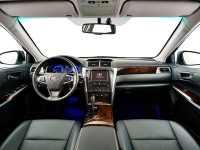
However, the Camry has its own advantages. On the armrest of the second row there are buttons to control the JBL multimedia system, which the competitor doesn't have.
There is more space in the back row inside the Camry. Especially it concerns the space above the head.
In a German, due to the lowering of the roof level, tall passengers will have to comb their hair across the ceiling. And if you sit on the back row in Passat SS, you risk not to straighten to your full height.
Ergonomics and seat comfort in both cars are equally good. But in terms of the trunk, the Toyota loses seriously: 506 liters of usable volume against 586 liters in VW.
In addition, the German has an electric trunk with a virtual pedal under the bumper. Both have a full-size wheel and a toolbox under the floor.
Driveability
Camry 2017 is famous for its softness. Smooth and power-consuming suspension successfully "swallows" any bumps. But in comparison with the opponent the Japanese lacks steering precision. Reaction to movements of the driver occurs with a delay, therefore on long distances you will be tired, constantly returning the automobile on a necessary trajectory. The car is certainly comfortable, but slow on the feedback. You will not be able to experience sharp sensations on it. Despite its sporty appearance, the 2015 Volkswagen Passat also does not spark drive. The car is quiet enough and is not distinguished by explosive dynamics. But you will not lag behind in a stream. The German's steering wheel is sharper and clearer. It is not the best in a class, but in comparison with Toyota it is more responsive.
Despite its sporty appearance, the 2015 Volkswagen Passat also does not spark drive. The car is quiet enough and is not distinguished by explosive dynamics. But you will not lag behind in a stream. The German's steering wheel is sharper and clearer. It is not the best in a class, but in comparison with Toyota it is more responsive.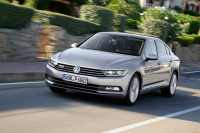 The Passat SS boasts a sharper handling. It has no special technical innovations that distinguish it from the standard Passat, but due to the lowering of the roof and center of gravity, as well as the wheels on low-profile rubber, the steering in the car is clearer.
The Passat SS boasts a sharper handling. It has no special technical innovations that distinguish it from the standard Passat, but due to the lowering of the roof and center of gravity, as well as the wheels on low-profile rubber, the steering in the car is clearer.
Toyota vs Volkswagen: who won?
Since the Passat B6 and the Camry 40, there has been fierce competition between the cars. Many buyers have spent more than one sleepless night wondering which car is better. However, as 15 years ago, and today, Toyota is a guarantee of reliability, and Volkswagen emphasizes the status of the owner.
One of the most controversial things about VAG-group cars is the DSG gearbox, which is also installed on 2018 models. Volkswagen offers customers 4 types of engines and 3 types of transmissions - 6MKPP, 6DSG and 7DSG.
The new Passat can be purchased with the following types of engines:
1,4 л. (125 hp);
1,4 л. (150 hp);
1,8 л. (180 hp);
2,0 л. TDI (150 hp).
If we take a similar complete set of both models, their average price tag will be about the same. Therefore, the cost will not significantly affect the choice of the buyer. There remains the destination and a matter of taste.
VW is more conservative, but in terms of interior design it looks more attractive and technologically advanced than its Japanese competitor. As for the manner of driving, the Camry is more comfortable to sit in the back seat, and the Passat - in the front seat. The cost of maintenance is about the same, since the Toyota replacement of some components, although cheaper, but the regulations require more often. Reliability remains! There is no equal to Toyota in this parameter yet. And availability of used parts in the secondary market makes repair of Camry more accessible. But it is only dry statistics and secondary arguments. Both cars are good in own way. Therefore, choose the car according to character, instead of figures!
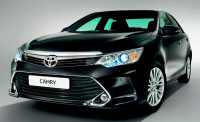

-rear-and-front-view-camera-6.png)
